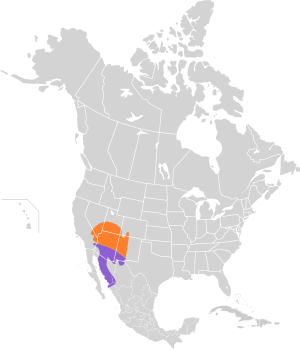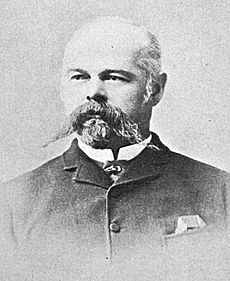Bendire's thrasher facts for kids
Quick facts for kids Bendire's thrasher |
|
|---|---|
 |
|
| Conservation status | |
| Scientific classification | |
| Genus: |
Toxostoma
|
| Species: |
bendirei
|
 |
|
The Bendire's thrasher (Toxostoma bendirei) is a bird that lives in the southwestern United States and northwestern Mexico. It is a type of thrasher, which is a group of birds known for their long tails and curved beaks.
This bird is about 23 to 28 centimeters (9 to 11 inches) long. It has a long tail and a medium-sized beak. Its feathers are grayish-brown on top. Its belly is lighter with faint dark streaks. You can often spot it by its bright yellow eyes. The bottom part of its beak is usually pale. The tips of its tail feathers are white.
Contents
Spotting a Bendire's Thrasher
It can be tricky to tell a Bendire's thrasher apart from a curve-billed thrasher. They look very similar! However, there are a few clues.
A grown-up Bendire's thrasher has a shorter beak than a curve-billed thrasher. But be careful, young curve-billed thrashers also have shorter beaks. The best ways to tell them apart are the Bendire's thrasher's bright yellow eyes. Also, the lower part of its beak is pale at the base. These features help bird watchers identify them correctly.
Where They Live
Bendire's thrashers live in dry, brushy areas. These include deserts and valleys in the southwestern United States. You can mostly find them along the border between Arizona and New Mexico with Mexico. They also live in unique mountain areas called Madrean Sky Islands. These are like "islands" of mountains rising out of the desert.
Building a Nest
The Bendire's thrasher builds a nest shaped like a cup. It uses twigs for the outside. Inside, it lines the nest with soft grass stems and small roots. They usually build their nests in a cactus or a thorny desert bush or tree.
The female bird lays three or four eggs. These eggs are a pale green or blue color. They have small brown and purple speckles on them.
What They Eat
Like many other thrashers, the Bendire's thrasher eats small insects. It finds these insects on the ground. They also enjoy eating berries.
Their Song
Bendire's thrashers are part of a bird family called "mimids." This means they often copy the songs and calls of other birds. They are usually quiet. But when they do make a sound, their most common call is a sharp "chek!"
How They Were Discovered
On July 28, 1872, a U.S. Army officer named Charles Bendire was exploring the desert. He was near Fort Lowell in Arizona. Charles Bendire loved birds. He saw a bird he didn't recognize.
Lieutenant Bendire carefully collected the bird, which seemed to be a female thrasher. He sent it to the Smithsonian Institution in Washington, D.C.. This is a famous museum and research center.
A scientist named Elliott Coues studied the bird. He was puzzled by it. Other scientists thought it was just a female curve-billed thrasher. But Coues disagreed. He believed it was a new species that no one had ever described before. He asked Bendire for more information. Bendire agreed that it seemed like a new type of bird.
Soon, Lieutenant Bendire sent another bird, a male, and details about its habits and eggs. These were different from the curve-billed thrasher. Finally, Coues was convinced. He named the new bird "Bendire's thrasher" to honor Charles Bendire.
Protecting Them
The Bendire's thrasher is listed as "Vulnerable." This means its numbers are going down. The main reason is that their desert homes are being turned into farmland. This takes away the places where they can live and find food.
See also
 In Spanish: Cuitlacoche piquicorto para niños
In Spanish: Cuitlacoche piquicorto para niños



